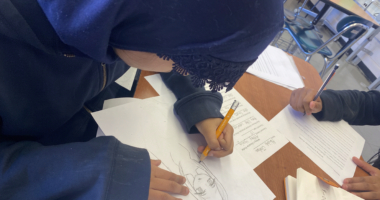I’m a performance artist – I turn the irritants of my life into dance/theatre work. You could say I am part oyster and part cat. Oyster because I attempt to make pearls, part cat just because.
For me, a large part of the TAP process is learning to turn my work as an artist into lessons. It’s as if I took an idea for a piece and got inside it so as to create a map for the journey, keeping the steps concrete and transparent enough to take the whole class with me. Just like my performance work, I want to create an experience, but more consciously so when I teach. And the value of being inside my process is I can use so many methods/intelligences to make sure every student comes with me.

In TAP Facilitator Heidi Miller’s class on Saturday, December 9th, she did not tell us what choreography was or even show us. We learned, instead, by doing. It was as if we got to jump into her process from the very first moment, reaching in both physically and with our imaginations. I am now learning to be super aware of the steps/questions I use in class. It feels like directing, in which planning, intuition, and spontaneity are key.
And speaking of directing, what I am learning at TAP will be useful in my own work as well as in the classroom. This is because my work involves eliciting material from my performers. I come with an idea, music, words and or movement and create the work with the actors, dancers, and community members in the work. My direction is to help my performers “tap” into a state of feeling, thinking, moving and speaking that is free of expectation. Being aware of what I am doing and seeing how other teachers think is opening up my world as an artist and a teacher. It’s as if I got a bit of a brain transplant – but got to keep most of it so I remember where I live and my cats names!

Part of the transformation comes from breaking through my resistance to what I first thought was layers of complication. At first, I remembered my own teachers who came to us without the deep process we are going through at TAP. We feasted on their offering and translated it for ourselves. They taught us their shtick. Often they had very rigid ideas of what was right and what was wrong. To get on with our own process as artists we often needed to repel what we’d learned. So it was terribly exciting, but almost as often a very confining process.
And it was a very different context than in the classroom. We are guests with a language and deep learning that has to be led, elicited, coached and – dare I say – scaffolded. Each school is its own world and each classroom its own town. I come to the classroom with a ton of empathy for the leader of that town because I know so much more about what teachers do than when I first taught in a school. Like parents, they all work incredibly hard. If their methods are focused on the negative and/or not taking in different learners, their work might be doubly hard.
My dance, painting and writing teachers teach in a different context. We met them at the door literally because we sought them out to do their idea/art form. At TAP, I am not told how to plan a unit – I’m actually experiencing it with my body, brain, and pen. My notes from our tap sessions are creative, I’m not worrying if I got it. The old dyslexic Alice is quiet, as my brain resets to a new place that (knock on wood everyone) believes I can do this.




